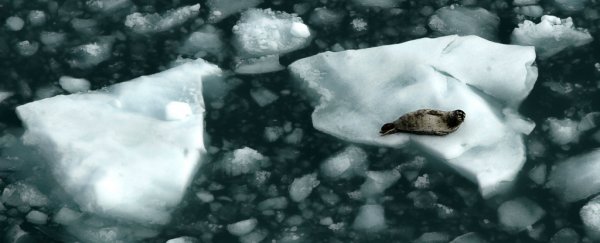Nowhere is climate change more obvious than in the Arctic. Experiencing rapid and, at times, unprecedented atmospheric change, the cold crest of our planet has taken on a burden greater than any other region in the world.
But while it's clear the Arctic is especially vulnerable to greenhouse gases, the physical causes that are driving this exceptional change - a phenomenon called Arctic amplification - remain elusive and are still strongly debated.
An international study has now disproved a popular explanation. While heat from the tropics can, in fact, swirl up to the Arctic and contribute to warming in the region, the whole thing has a negligible effect on Arctic amplification - usually calculated as the ratio of polar warming to tropical warming.
Using complex computer simulations, the researchers suggest instead that the local effects of carbon dioxide within the Arctic itself are driving this phenomenon.
"This study is significant as it disproves previously suggested hypotheses of the cause of Polar Amplified warming, showing that local greenhouse gas concentrations, and Arctic climate feedbacks outweigh the impact of remote processes," says co-author Shayne McGregor, a climate scientist from Monash University in Australia.
Arctic sea ice plays a crucial role in balancing the world's climate, which means that changes here will have far-reaching effects, causing repercussions that will touch ecosystems everywhere, not to mention human society.
Getting an accurate prediction for polar warming is, therefore, a critical component of climate models. And understanding the factors that drive polar warming will only help us in that calculation.
This new study is changing our understanding of one important factor, called the vertical atmospheric temperature profile. It sounds complicated, but it just has to do with the distribution of carbon dioxide in the atmosphere.
In the Arctic, carbon dioxide has an opposite vertical distribution than in the tropics, and the recent research suggests this is what's causing the polar region such strife compared to the rest of the world.
In the tropics, where temperature and moisture is high, air can travel more easily through the atmosphere, rising to higher and higher altitudes. As carbon dioxide climbs further along with it, the upper atmosphere is warmed and the resulting energy can easily slip out into space.
But in the Arctic, something different happens. The temperature is colder and the air doesn't move as quickly to the upper atmospheres; its movement is more stable. This means that carbon dioxide heats up lower parts of the atmosphere more, so not quite as much energy can escape into space.
Infrared radiation from the Sun, thus, becomes trapped more easily in Earth's atmosphere, amplifying the warming of Arctic.
Even compared to other local effects, the vertical atmospheric profile has an unequalled effect on Arctic amplification.
"Our computer simulations show that these changes in the vertical atmospheric temperature profile in the Arctic region outweigh other regional feedback factors, such as the often-cited ice-albedo feedback," says Stuecker.
The ice-albedo feedback is when carbon dioxide heats the atmosphere, melting snow and sea ice and reducing the reflection of the Arctic surface. This lets sunlight pierce the top layers of the soil and the ocean more easily, accelerating the warming process.
But while this feedback system does contribute to warming in the Arctic, the new study suggests it doesn't exacerbate the problem quite as much as we thought. And it certainly isn't as impactful as the vertical distribution of carbon dioxide in the Arctic atmosphere.
The same goes for local changes in Arctic clouds, currents of warm ocean water that seep into the Arctic, and hot winds that flow there during El Niño events.
"Our simulations demonstrate that remote physical processes from outside the polar regions do not play a major role, in contrast to previous suggestions," Stuecker concludes.
The debate is likely to continue, but the new findings have given a little more insight into which physical processes contribute most to the rapid retreat of Arctic sea ice.
This study has been published in Nature Climate Change.
